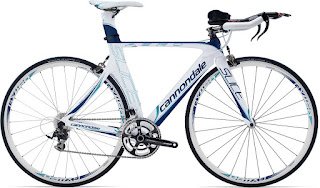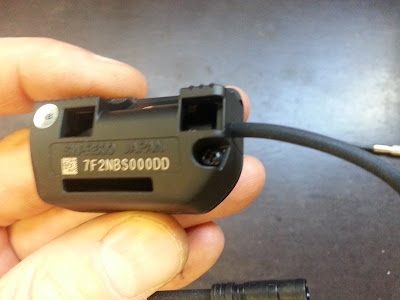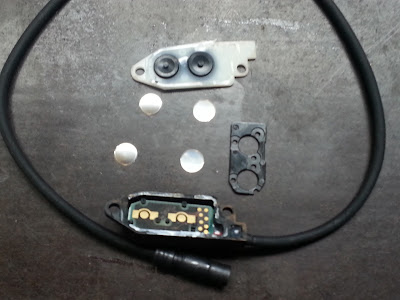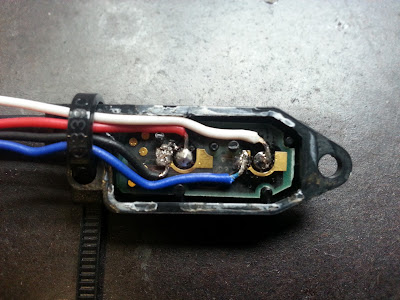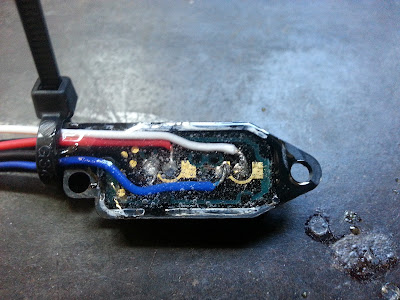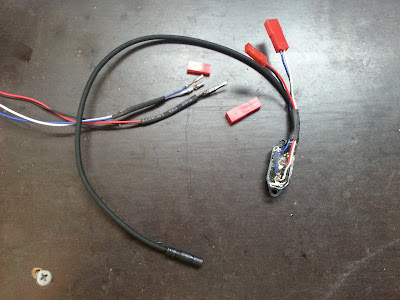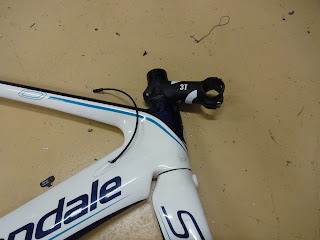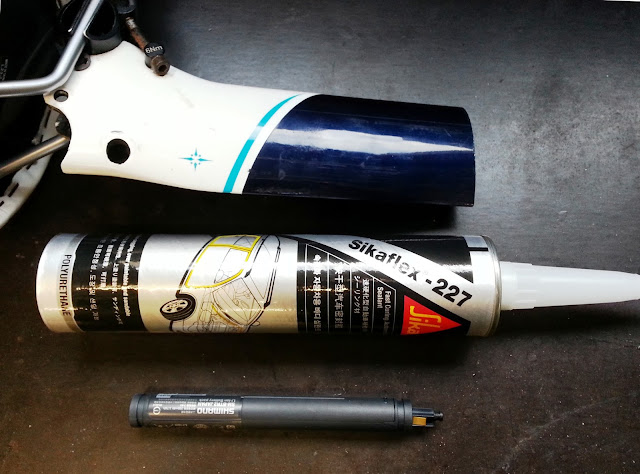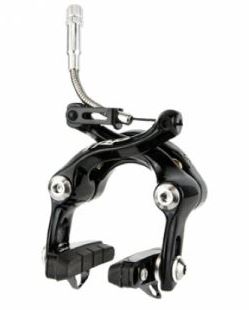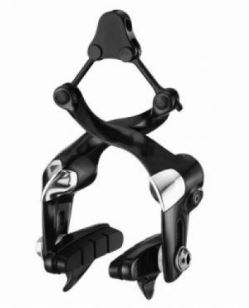I have already progressed the DIY shift somewhat and this is discussed in a previous post.
My plan is as follows:
- Start with the new carbon handlebars
- Install the Cateye #169-9200 buttons for shifting the rear derailleur
- Install the R600 circuit board inside the stem
- Internally wire between the buttons to the R600 circuit board
- Wire from the R600 circuit board to the 5 port module on the stem
- Reassemble with new brake cables
First I prepare the handlebars. They are not designed what I have in mind so I need to drill a few holes. I keep these holes around 3mm as I only intend to pull the very small 24AWG cables through them. I don't need to feed any of the 5mm E-tube plugs through the bars.
Cables are fed from small holes in the back of the stem clamp area out to each bar end. As with the main frame this was very tricky and I used old inner brakes cables as feeder wires.
A small hole is drilled on the inner side of each bar end 40mm from the end of the tube. It needs to back from the end to clear the brake levers which insert in the tubes later.I fish the wires through and out of this hole.
At this stage I use a multimeter (or test light) to make sure the wires are still continuous and have not been damaged while I was pulling them through.
Next I add the buttons at each bar end. There are a couple of ways to go about this:
- I could cut the Cateye cables and splice my wires onto them (Non-preferred)
- Connect my wires directly to the buttons (Preferred)
The picture below shows the buttons opened up which is very easy to do. There was a small amount of sealant holding it together which I replaced with some 5 minute epoxy. I de-solder the existing wires, pass my, more robust, wires through the button cover and solder them on to the same terminals:
I was on a roll and forgot to take pictures along the way but here is the end results with a button installed on the underside of the handlebars.
The button holders have some small cable guides moulded into them that clamp the cables and offer some strain relief. Later the bar tape will wrap over and conceal these buttons.
Surprisingly when I did this on my Shiv upgrade a while back I found that even with thick winter gloves the buttons are every easy to use under the bar tape.
The other end of the cables at the stem get a set of the small red JST plugs to match those on the R600 module board and and I feed the brake cables through the designated holes under the bars and the whole assembly is now ready.
Next I move onto the stem and hiding the R600 rear derailleur control module.
I need to hide the R600 climbing module because it is just a control board removed from the shifter, is pretty ugly and no longer has a proper housing to mount it. I decide to hide it in the stem but this means I need to drill a hole in the stem to get the E-tube wire out and around to the 5 port module on top of the stem.
I am very careful about where I drill the stem as I don't want to weaken a high stress area. A handlebar stem is a cantilever so when the rider puts weight on the bars the steam he top of the stem has the highest tensile stresses and the fork clamp area see the highest bending loads due to the lever action.
Image below shows the underside of the stem with the 5.5mm hole drilled on the underside and toward the handlebar end but not too close to the threads which may have local stresses from the bolt tensioning
I route the E-tube wire from inside the stem up to the module on the top. The module strap helps secure the cable to the stem. The R600 module is wrapped with foam and zip ties which will stop it rattling inside the stem
The excess E-tube cable is wrapped around the module and it is all poked into the stem
Now the handlebars can be fitted and the internal wiring connected
From here it is just a matter of re-installing the aerobars, bar end shifters and the brake cables which I will write about soon.
